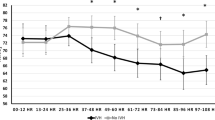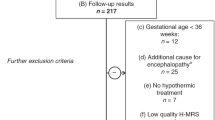Abstract
OBJECTIVE: Prediction of neurologic outcome is difficult in neonates with acute nervous system injury. Previous studies using proton magnetic resonance spectroscopy (1H-MRS) have been used to predict short-term neurologic outcome in neonates with a variety of neurologic insults. We were interested in determining the effectiveness of combining clinical evaluation and spectroscopy obtained at the time of injury in predicting neurologic outcome at 24 months.
STUDY DESIGN: We studied 33 neonates with acute central nervous system injury, 5.8±3.7 days of injury, owing to hypoxic–ischemic encephalopathy. Neonates were assessed using clinical variables (initial arterial pH, initial blood glucose, Sarnat score, electroencephalography) and spectroscopy (NAA/Cho, NAA/Cre, Cho/Cre, and lactate). Neonates were divided into two outcome groups: good/moderate and poor. Differences between the groups were assessed using χ2 and t-test analyses. We analyzed the best predictors of outcome using discriminant analysis and calculated sensitivity, specificity, positive, and negative predictive values for each variable independently and in combination.
RESULTS: There were significant differences between the good/moderate and poor outcome for the Sarnat score, EEG, lactate, and NAA/Cho. Spectroscopy combined with clinical variables improved sensitivity, but not specificity for predicting outcome. The presence of lactate had the best individual predictive value. Combination of the clinical with the MRS variables had the highest predictive value.
CONCLUSION: Proton magnetic resonance spectroscopy done early after injury improves the ability to predict neurologic outcome at 24 months of age.
This is a preview of subscription content, access via your institution
Access options
Subscribe to this journal
Receive 12 print issues and online access
$259.00 per year
only $21.58 per issue
Buy this article
- Purchase on Springer Link
- Instant access to full article PDF
Prices may be subject to local taxes which are calculated during checkout
Similar content being viewed by others
References
Volpe JJ . Hypoxic–ischemic encephalopathy: clinical aspects. In: Volpe JJ, editor. Neurology of the Newborn. 3 ed. Philadelphia: WB Saunders, Co; 1995. p. 314–369.
Robertson CM, Finer NN, Grace MG . School performance of survivors of neonatal encephalopathy associated with birth asphyxia at term. J Pediatr 1989;114:753–760.
Nelson KB, Ellenberg JH . Apgar scores as predictors of chronic neurologic disability. Pediatrics 1981;68:36–44.
Sarnat HB, Sarnat MS . Neonatal encephalopathy following fetal distress. A clinical and electroencephalographic study. Arch Neurol 1976;33:696–6705.
Majnemer A, Rosenblatt B . Evoked potentials as predictors of outcome in neonatal intensive care unit survivors: review of the literature. Pediatr Neurol 1996;14:189–195.
Holmes G, Rowe J, Hafford J, Schmidt R, Testa M, Zimmerman A . Prognostic value of the electroencephalogram in neonatal asphyxia. Electroencephalogr Clin Neurophysiol 1982;53:60–72.
Rosenkrantz TS, Zalneraitis EL . Prediction of survival in severely asphyxiated infants. Pediatr Neurol 1991;7:446–451.
Barkovich AJ, Westmark K, Partridge C, Sola A, Ferriero DM . Perinatal asphyxia: MR findings in the first 10 days. Am J Neuroradiol 1995;16:427–438.
Nelson KB, Emery III ES . Birth asphyxia and the neonatal brain: what do we know and when do we know it? Clin Perinatol 1993;20:327–344.
Shevell MI, Ashwal S, Novotny E . Proton magnetic resonance spectroscopy: clinical applications in children with nervous system diseases. Semin Pediatr Neurol 1999;6:68–77.
Shu SK, Ashwal S, Holshouser BA, Nystrom G, Hinshaw Jr DB . Prognostic value of 1H-MRS in perinatal CNS insults. Pediatr Neurol 1997;17:309–318.
Holshouser BA, Ashwal S, Luh GY, et al. Proton MR spectroscopy after acute central nervous system injury: outcome prediction in neonates, infants, and children. Radiology 1997;202:487–496.
Ashwal S, Holshouser BA, Tomasi LG, et al. 1H- magnetic resonance spectroscopy-determined cerebral lactate and poor neurological outcomes in children with central nervous system disease. Ann Neurol 1997;41:470–481.
Groenendaal F, Veenhoven RH, van der Grond J, Jansen GH, Witkamp TD, de Vries LS . Cerebral lactate and N-acetyl-aspartate/choline ratios in asphyxiated full-term neonates demonstrated in vivo using proton magnetic resonance spectroscopy. Pediatr Res 1994;35:148–151.
Barkovich AJ, Baranski K, Vigneron D, et al. Proton MR spectroscopy for the evaluation of brain injury in asphyxiated, term neonates. Am J Neuroradiol 1999;20:1399–1405.
Nelson KB, Ellenberg JH . Children who “outgrew’ cerebral palsy. Pediatrics 1982;69:529–536.
Piper MC, Mazer B, Silver KM, Ramsay M . Resolution of neurological symptoms in high-risk infants during the first two years of life. Dev Med Child Neurol 1988;30:26–35.
Fiser DH . Assessing the outcome of pediatric intensive care. J Pediatr 1992;121:68–74.
Holshouser BA, Ashwal S, Shu S, Hinshaw Jr DB . Proton MR spectroscopy in children with acute brain injury: comparison of short and long echo time acquisitions. J Magn Reson Imaging 2000;11:9–19.
Klose U . In vivo proton spectroscopy in presence of eddy currents. Magn Reson Med 1990;14:26–30.
Ashwal S, Holshouser BA, Hinshaw Jr DB, Schell RM, Bailey L . Proton magnetic resonance spectroscopy in the evaluation of children with congenital heart disease and acute central nervous system injury. J Thorac Cardiovasc Surg 1996;112:403–414.
Kreis R, Ernst T, Ross BD . Development of the human brain: in vivo quantification of metabolite and water content with proton magnetic resonance spectroscopy. Magn Reson Med 1993;30:424–437.
Urenjak J, Williams SR, Gadian DG, Noble M . Proton nuclear magnetic resonance spectroscopy unambiguously identifies different neural cell types. J Neurosci 1993;13:981–989.
Bhakoo KK, Pearce D . In vitro expression of N-acetyl aspartate by oligodendrocytes: implications for proton magnetic resonance spectroscopy signal in vivo. J Neurochem 2000;74:254–262.
Peden CJ, Rutherford MA, Sargentoni J, Cox IJ, Bryant DJ, Dubowitz LM . Proton spectroscopy of the neonatal brain following hypoxic–ischaemic injury. Dev Med Child Neurol 1993;35:502–510.
Robertson NJ, Cox IJ, Cowan FM, Counsell SJ, Azzopardi D, Edwards AD . Cerebral intracellular lactic alkalosis persisting months after neonatal encephalopathy measured by magnetic resonance spectroscopy. Pediatr Res 1999;46:287–296.
Roelants-Van Rijn AM, van der Grond J, de Vries LS, Groenendaal F . Value of 1H-MRS using different echo times in neonates with cerebral hypoxia–ischemia. Pediatr Res 2001;49:356–362.
Foz FB, Lucchini FL, Palimieri S, et al. Language plasticity revealed by electroencephalogram mapping. Pediatr Neurol 2002;26:106–115.
Hertz-Pannier L, Chiron C, Jambaque I, et al. Late plasticity for language in a child's non-dominant hemisphere: A pre- and post-surgery fMRI study. Brain 2002;125:361–372.
Penrice J, Lorek A, Cady EB, et al. Proton magnetic resonance spectroscopy of the brain during acute hypoxia–ischemia and delayed cerebral energy failure in the newborn piglet. Pediatr Res 1997;41:795–7802.
Lorek A, Takei Y, Cady EB, et al. Delayed (“secondary”) cerebral energy failure after acute hypoxia–ischemia in the newborn piglet: continuous 48-hour studies by phosphorus magnetic resonance spectroscopy. Pediatr Res 1994;36:699–6706.
During MJ, Fried I, Leone P, Katz A, Spencer DD . Direct measurement of extracellular lactate in the human hippocampus during spontaneous seizures. J Neurochem 1994;62:2356–2361.
Lanfermann H, Kugel H, Heindel W, Herholz K, Heiss WD, Lackner K . Metabolic changes in acute and subacute cerebral infarctions: Findings at proton MR spectroscopic imaging. Radiology 1995;196:203–210.
Petroff OA, Graham GD, Blamire AM, et al. Spectroscopic imaging of stroke in humans: histopathology correlates of spectral changes. Neurology 1992;42:1349–1354.
Hetherington H, Kuzniecky R, Pan J, et al. Proton nuclear magnetic resonance spectroscopic imaging of human temporal lobe epilepsy at 4.1 T. Ann Neurol 1995;38:396–3404.
Saunders DE, Howe FA, van den Boogaart A, Griffiths JR, Brown MM . Discrimination of metabolite from lipid and macromolecule resonances in cerebral infarction in humans using short echo proton spectroscopy. J Magn Reson Imaging 1997;7:1116–1121.
Author information
Authors and Affiliations
Rights and permissions
About this article
Cite this article
Kadri, M., Shu, S., Holshouser, B. et al. Proton Magnetic Resonance Spectroscopy Improves Outcome Prediction in Perinatal CNS Insults. J Perinatol 23, 181–185 (2003). https://doi.org/10.1038/sj.jp.7210913
Published:
Issue Date:
DOI: https://doi.org/10.1038/sj.jp.7210913
This article is cited by
-
Early proton magnetic resonance spectroscopy during and after therapeutic hypothermia in perinatal hypoxic–ischemic encephalopathy
Pediatric Radiology (2019)
-
Magnetic resonance spectroscopy in very preterm-born children at 4 years of age: developmental course from birth and outcomes
Neuroradiology (2018)
-
Key concepts in MR spectroscopy and practical approaches to gaining biochemical information in children
Pediatric Radiology (2016)
-
Magnetic resonance spectroscopy as a prognostic marker in neonatal hypoxic-ischemic encephalopathy: a study protocol for an individual patient data meta-analysis
Systematic Reviews (2013)
-
Brain metabolite concentrations are associated with illness severity scores and white matter abnormalities in very preterm infants
Pediatric Research (2013)



